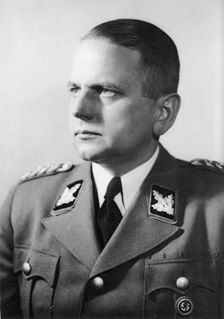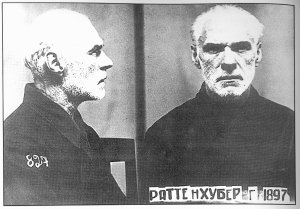 W
WThe 6th Army was a field army unit of the German Wehrmacht during World War II (1939–1945). It was widely remembered for being the most highly decorated German army unit until its defeat by the Red Army at the Battle of Stalingrad in the winter of 1942–1943. It also acquired a reputation for the war crimes that it committed under the command of Field Marshal Walther von Reichenau during Operation Barbarossa.
 W
WPaul Blobel was a German SS commander and convicted war criminal who had a prominent role in the Holocaust. He was the key figure in organising and executing the Babi Yar massacre of 1941 and in June 1942, Blobel was put in charge of Sonderaktion 1005, with the task of destroying the evidence of Nazi atrocities in Eastern Europe. After the war, he was convicted at the Einsatzgruppen Trial and executed.
 W
WKarl Rudolf Werner Braune was a German SS functionary during the Nazi era and a Holocaust perpetrator. During the German invasion of the Soviet Union of 1941, Braune was the commander of Einsatzkommando 11b, part of Einsatzgruppe D. Braune organized and conducted mass murders of Jews in the Army Group South Rear Area, the Reichskommissariat Ukraine. For his role in these crimes, Braune was tried before the Nuremberg Military Tribunal in 1948 in the Einsatzgruppen trial. He was convicted, sentenced to death and executed in 1951.
 W
WKurt Eberhard was a German Nazi officer. He rose to the rank of Brigadeführer of the SS and in the German army. During World War II Eberhard was given the command over the occupied city of Kiev in Ukraine. He was involved in planning and supervising the Babi Yar massacres during which over 33,771 people were murdered. He was captured by US authorities after the end of World War II, in November 1945, and kept in captivity in Stuttgart. He committed suicide on September 8, 1947.
 W
WHans Otto Georg Hermann Fegelein was a high-ranking commander in the Waffen-SS of Nazi Germany. He was a member of Adolf Hitler's entourage and brother-in-law to Eva Braun through his marriage to her sister Gretl.
 W
WLothar Fendler was an SS-Sturmbannführer, in Sonderkommando 4b of Einsatzgruppe C and was involved in the murder of the Jews in occupied Ukraine. At the Einsatzgruppen Trial in 1948 Fendler was sentenced to ten years in prison but was released in 1951.
 W
WEmil Haussmann was a German SS functionary during the Nazi era. He was part of Einsatzkommando 12 of Einsatzgruppe D, which perpetrated the Holocaust in occupied Ukraine. Haussmann was charged with crimes against humanity in 1947 in the Einsatzgruppen Trial. He committed suicide while in prison.
 W
WFriedrich Jeckeln was a German SS commander during the Nazi era. He served as a Higher SS and Police Leader in the occupied Soviet Union during World War II. Jeckeln was the commander of one of the largest collection of Einsatzgruppen death squads and was personally responsible for ordering and organizing the deaths of over 100,000 Jews, Romani, and others designated by the Nazis as "undesirables". After the end of World War II in Europe, Jeckeln was convicted of war crimes by a Soviet military tribunal in Riga and executed in 1946.
 W
WErnst Kaltenbrunner was a high-ranking Austrian SS official during the Nazi era and a major perpetrator of the Holocaust. He was the subsequent Chief of the Reich Security Main Office (RSHA), which included the offices of Gestapo, Kripo, and SD, from January 1943 until the end of World War II in Europe.
 W
WFritz Katzmann, also known as Friedrich Katzmann, was a German SS and police official during the Nazi era. He perpetrated genocide in the cities of Katowice, Radom, Lemberg (Lwów), Danzig (Gdańsk), and across the Nazi German District of Galicia during the Holocaust in occupied Poland, making him a major figure during the Holocaust there.
 W
WErich Koch was a Gauleiter of the Nazi Party (NSDAP) in East Prussia from 1 October 1928 until 1945. Between 1941 and 1945 he was Chief of Civil Administration of Bezirk Bialystok. During this period, he was also the Reichskommissar in Reichskommissariat Ukraine from September 1941 until August 1944 and in Reichskommissariat Ostland from September 1944. After the Second World War, Koch stood trial in Poland and was convicted in 1959 of war crimes and sentenced to death. The sentence was never carried out and Koch died of natural causes in his cell at the Barczewo prison on the 12 November 1986.
 W
WErhard Kroeger or Kröger was a Baltic German SS officer involved in the resettlement of Baltic Germans before World War II. He commanded an Einsatzgruppe in 1941, and was later attached to General Andrey Vlasov and the German sponsored Russian Liberation Army of World War II. He was convicted of war crimes in 1969.
 W
WFelix Landau was a SS Hauptscharführer, a member of an Einsatzkommando during World War II, based first in Lwów, Poland, and later in Drohobycz. He was a "central figure in the Nazi program of the extermination of Galician Jews". He is known for his daily diary and for temporarily sparing the life of the Jewish/Polish artist Bruno Schulz in 1942. Landau liked Schulz's art and supplied him with protection and extra food. In return, he ordered the artist to paint a set of murals for his young son's bedroom, depicting scenes from the Brothers Grimm fairy tales. Landau also was the SS officer assigned to watch over Maria Altmann, the subject of the 2015 film Woman in Gold.
 W
WPieter Nicolaas Menten was a Dutch war criminal, businessman, and art collector.
 W
WGustav Adolf Nosske was a German lawyer and SS-Obersturmbannführer. In 1941–42, he commanded Einsatzkommando 12 within Einsatzgruppe D, under the command of Otto Ohlendorf. Tried in the Einsatzgruppen Trial in 1948, Nosske was sentenced to life imprisonment. He was released early in 1955.
 W
WOtto Ohlendorf was a German SS functionary and Holocaust perpetrator during the Nazi era. An economist by education, he was head of the Sicherheitsdienst (SD) Inland, responsible for intelligence and security within Germany. In 1941, Ohlendorf was appointed the commander of Einsatzgruppe D, which perpetrated mass murder in Moldova, south Ukraine, the Crimea and, during 1942, the North Caucasus. He was tried at the Einsatzgruppen Trial, convicted and executed in 1951.
 W
WPaul Otto von Radomski was an SS functionary of Nazi Germany. During World War II, he commanded the Syrets concentration camp in the occupied Ukraine, and the Haidari concentration camp, near Athens, Greece.
 W
WEmil Otto Rasch was a high-ranking German Nazi official and Holocaust perpetrator, who commanded Einsatzgruppe C in northern and central Ukraine until October 1941. After World War II, Rasch was indicted for war crimes at the Einsatzgruppen trial, but the case was discontinued for medical reasons in 1948. He died in 1948 while in custody.
 W
WJohann Rattenhuber, also known as Hans Rattenhuber, was a German police and SS general. Rattenhuber was the head of German dictator Adolf Hitler's personal Reichssicherheitsdienst bodyguard from 1933 to 1945. In January 1942, Rattenhuber's RSD units participated in the mass shooting of 227 Jews at Strizhavka. After the war, he was released from Soviet prison on 10 October 1955 and allowed to go to West Germany. He died in Munich in 1957.
 W
WWalter Karl Ernst August von Reichenau was a field marshal in the Wehrmacht of Nazi Germany during World War II. Reichenau commanded the 6th Army, during the invasions of Belgium and France. During Operation Barbarossa, the invasion of the Soviet Union, he continued to command the 6th Army as part of Army Group South as it captured Ukraine and advanced deep into Russia.
 W
WWalter Schimana was an Austrian functionary in the German SS during the Nazi era. He was SS and Police Leader in the occupied Soviet Union in 1942 and Higher SS and Police Leader in occupied Greece from October 1943. Responsible for numerous war crimes and atrocities in the occupied territories, Schimana was arrested by the Allies after the war and committed suicide while awaiting trial.
 W
WErwin Schulz was a German member of the Gestapo and the SS in Nazi Germany. He was the leader of Mission squad 5, part of Einsatzgruppe C, which was attached to the Army Group South during the planned invasion of Soviet Union in 1941, and operated in the occupied territories of south-eastern Poland and Ukrainian SSR committing mass killings of civilian population, mostly of Jewish ethnicity, under the command of SS-brigadier general Otto Rasch.
 W
WDieter Wisliceny was a member of the Schutzstaffel (SS), and a key executioner in the final phase of the Holocaust.